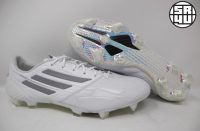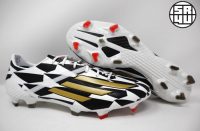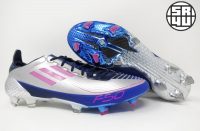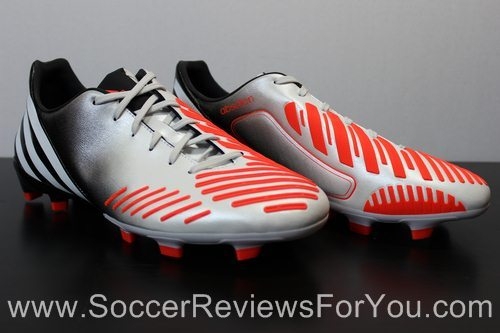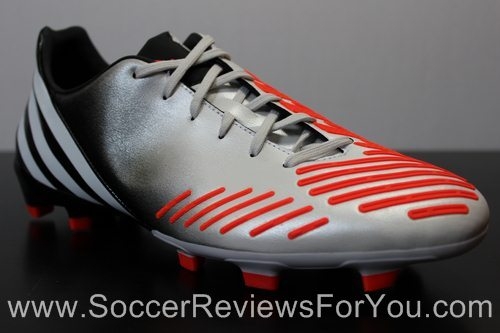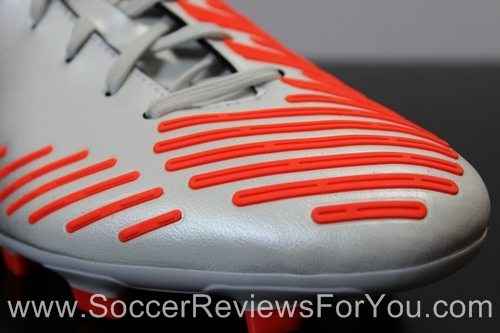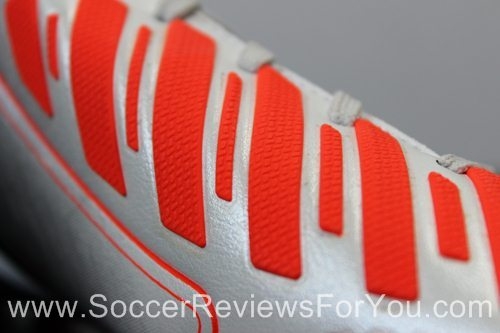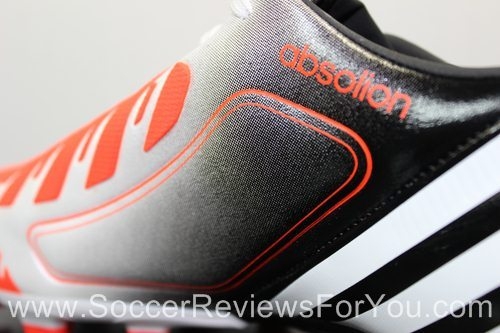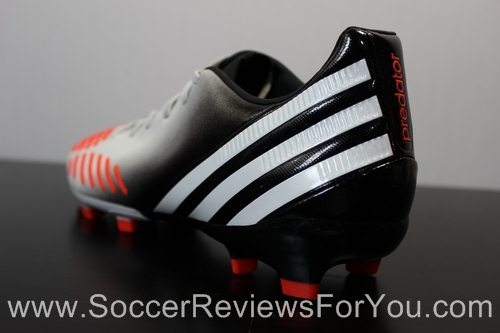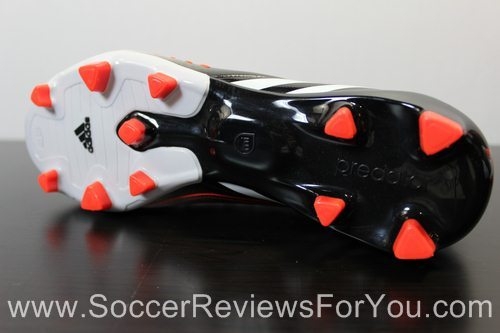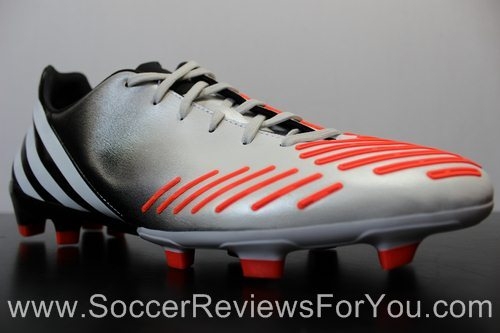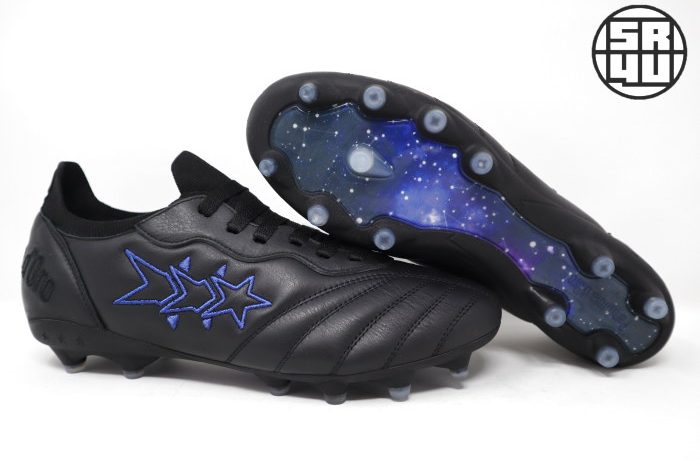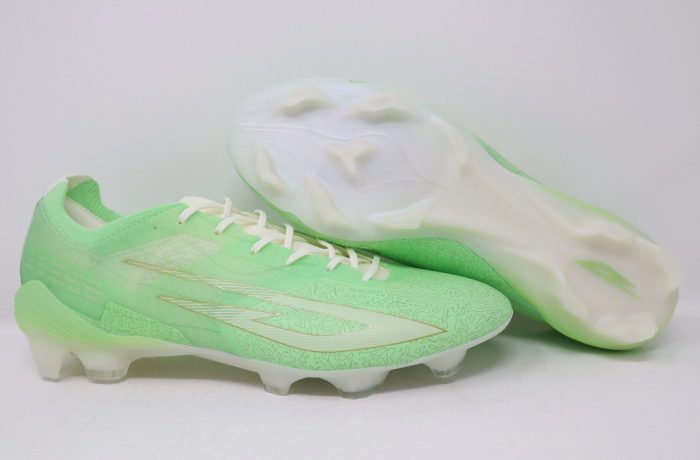The Predator Absolion LZ is the first takedown model, in the somewhat controversial line of shoes that is the Adidas Predator LZ, with plenty of features carrying over from the top end model. From right out of the box, the Absolion LZ does require a couple of hours of break-in time until you will start to feel completely comfortable. This is not a shoe that is going to give you any blistering or cause any discomfort from rubbing, because the shoe actually fits pretty well. Where you will experience discomfort in the first couple of hours of use will be from the stiffness of the boot.
The synthetic upper, the soleplate and the narrower cut through the mid-foot all make for a shoe that can cause some foot cramping, which is pretty much the only break-in issue that I had with the Absolion LZ. The synthetic upper on the Absolion is slightly thicker than what you will find on the top end LZ, making the Absolion upper much stiffer and not nearly as soft. While the upper is still decent quality, it definitely is not up to the same level of quality of the top end model. Another major difference that I noticed on the Absolion was the stiffer soleplate. While aesthetically it appears to be the same as the top end LZ, the plastic itself is much less flexible, which is something that I personally was not a fan of. Of course the soleplate will become more flexible over time, the stiff soleplate is not ideal, and is just not something that I am a huge fan of. Other comfort elements include a synthetic suede heel liner, and a decently padded insole, but if you want the most comfortable version of the LZ, the top end model is what you want.
The fit of the shoe is also a little on the strange side, which always seems to be the case with the Absolion model. The shoe seems to have a slightly narrower cut to it, which is ok for some, but is not so great for everybody else. The mid-foot hugs the instep of your foot very tightly, and it is one of those shoes that just feels uncomfortable if you pull the laces just a little too tight, which is an issue that I don’t normally have. Another reason for the more narrow fit is the synthetic upper itself. The upper is much stiffer, and unlike the top end LZ, the Absolion’s upper has barely any stretch to it. For whatever reason, I find the Absolion to feel very restrictive on your foot, especially if you have a wider foot. So, if you are a wider footed player, I would stay away from the Absolion LZ, and if you must have something from the LZ line, I would strongly recommend going for the top end model. As far as sizing is concerned, the Absolions fit true to size. I wore my usual size 9US for review, and the fit of the shoe in the length was perfect. So, if you’re looking to order a pair of Absolion LZs, I would strongly recommend going for your regular size.
Weight
The Absolion LZ weighs in at a respectable 9.4oz. This is about average weight for most modern soccer shoes, and is certainly not something that is going to weigh you down. The top end LZ has a listed weight of 8oz, which is a fair bit lighter in your hands, but on your feet, it is next to impossible to feel any kind of difference in weight between the two.
Traction
This is the first Predator in a while to not offer the classic Adidas bladed stud pattern. Adidas has instead opted to change all of their shoe lines to variations on the adizero stud pattern, which is the most popular shoe in the line. While this isn’t necessarily a bad thing, it may upset some long-time Pred wearers who have been wearing the same stud pattern for the last little while. This is another move away from the label of a “power” boot for the LZ, offering a stud pattern that is arguably as solid of a stud pattern as perhaps the older bladed one was. When I say “solid” I am speaking simply on the basis of shooting, with the bladed stud pattern offering more of a stable feel when planting your foot to strike the ball. With all of that aside, the LZ offers a stud pattern that is nearly identical to that of the adizero. The studs are all triangular shaped, offering somewhat of a combination feel between blades and conical studs. The stud pattern is best suited for firm to slightly softer ground, simply because the studs are slightly on the longer side, and because of the larger surface area of the studs, they will not penetrate the ground unless the ground is a little softer. Given that the conditions are right, the stud pattern performs and feels very good. It offers plenty of grip when pushing off for a sprint, which is great. This is a stud pattern that is definitely usable on turf, but again, I do find the studs to be a little on the long side. If you’ve worn the adizero, which many have, than the stud pattern on the LZ should feel exactly the same for you.
Touch
What makes the Absolion LZ such an attractive option are the “Lethal Zones”, which are identical to the zones on the top end version of the LZ. The LZ has really gone over the top with the use of rubber on the upper. If you have seen any of the marketing, which I am sure that you probably have, the LZ, which stands for “Lethal Zones” is what the new Predator is all about. The idea is that a blank white shoe was given to all of the top professionals, and they were asked to circle the spots on the shoe that they use most. Through comparing all of the results, five zones were established and placed on what is the new Predator. While I do think that this is a good idea and everything about it does make sense, the of rubber across the entire upper of the shoe is nothing new to soccer shoes, it has just never been marketed in such a way that got people so excited. One shoe that comes to mind that offered just as much rubber on the upper is the Nike T90 Laser II, for those of you who can remember back a few years. So, as expressed by Adidas, each of the five “Lethal Zones” serves its own unique purpose, each specifically designed for the following: passing, striking the ball, swerve, dribbling and control. The LZ is not necessarily the first of its kind, but it is the first to be marketed a shoe that can be thrown into various categories of marketing.
So, how is the touch on the LZ? The answer to that question is that some will love it, while others will hate it, and it’s that simple. If you are really into having a plain leather upper or are not a fan of having a lot of grip on the ball, straight away, the LZ is not for you. The instep features the “passing” zone, which is a section with a layer of memory foam on the upper. The foam is on the thinner side, but is definitely is noticeable and is probably my favorite part of the shoe. It offers just a little bit of extra padding when touching or passing the ball with the instep, but is nothing overly different in terms of feel than what you can get from a quality leather upper. The “swerve” element is positioned on the instep of the forefoot, and while the main purpose that it is supposed to serve is for shooting, it is going to be the main thing that is going to take getting used to on the LZ. The element is very grippy, and because it is positioned in easily one of the most commonly used spots of the foot, it will take some adjusting to get used to it. This is also something that I am not sure about with the LZ. Why should I have to change my technique in order to feel comfortable with my touch on the ball just because of the shoes on my feet? If you are someone who tends to push or drag the ball when playing, something that I personally do enough of, the “swerve” element will not exactly allow for that because of how much grip it provides. While I eventually did find myself getting used to it after 3 to 4 hours of use, I can honestly say that it is something that I just really didn’t like when I first started wearing the LZ. Like I said, I did get used to it, but I did find myself touching the ball differently in the LZ than I would in another shoe. The LZ is not going to offer more control, and no shoe will, but it will offer a lot more grip on the ball, which some will like and others will not.
The next zone on the shoe that is touch related is the “First Touch” zone, located right on top of your toes. The idea is again, to provide more grip on the ball, which is supposed to make for better control. The strips of rubber on this zone are made of a much harder rubber and provide very little grip against the ball. It is easily the least noticeable rubber element on the boot, and really doesn’t provide any type of unique feel. The last touch-related element on the shoe is the “Dribble” element, located on the outside of the forefoot. It is made up of several small, thin strips of rubber, making for a little bit of extra grip on the ball when dribbling with the outside of the foot. This again is something that you are either going to love or hate. This was never an area of the foot that I ever felt that extra grip was necessary, so like I said, if you tend to drag the ball rather than push it, you might not be a fan of the extra grip.
To sum up this very lengthy explanation of the feel that the Predator LZ provides, I can honestly say that I came to like the feel of the LZ. I am not a big fan of having rubber elements on parts of the shoe that are regularly touching the ball when you are not shooting, and I am still not a big fan. Once I did get used to the LZ, and there does seem to be somewhat of a learning curve so you aren’t stumbling over the ball from all of the extra grip, I did come to like the touch of the LZ to an extent. Do I think that the LZ will help you with your touch? The answer is very simply no, and for some, the extra grip will just frustrate you.
Shooting
Given that this is a Predator, a shoe that has always been about shooting, you would expect the newest version of the Predator to provide a solid feel for shooting. We’ll start with the only “Lethal Zone” that I have yet to mention, and that is the “Drive” zone. This is the main striking element located right on top of the foot, spanning about the same surface area as the previous version of the Predator, the adiPower. Like the overall make up of the shoe, the striking element is also somewhat stripped down. Even though the striking elements is the thickest rubber on the shoe, it is still fairly thin in comparison to most striking elements that we see on a lot of “Power” boots on the market. The problem that I have with the striking element is that it doesn’t provide that solid surface that I feel a striking element should have. The reason for this is because the rubber sits on top of the actual upper of the shoe, rather than being an actual cut out in the upper, again like the adiPower. The result of having the striking element over top of the upper is that you get more of a cushioned feel when striking the ball rather than a direct impact, if that makes any sense. This is a similar complaint that I had with the Nike T90 Laser IV. This does not mean that you are not going to be able to strike the ball as hard, you just won’t get that feel that I think that a striking element should provide. The second striking element on the LZ is the previously explained “Swerve” zone. Like I explained earlier, it does provide some extra grip, but nothing that is going to allow you to curl the ball any more than you would normally be able too. Again going back to the Laser IV, I feel like the fins that hang off on the instep provide just as much, if not more grip than the LZ swerve element. Keep in mind that rubber elements will not allow for more spin on the ball, it will just allow for more spin on the ball without as good of a technique. Essentially it is a helper, but if you can’t curl the ball in the first place, no striking element on earth is going to help you. It is definitely not stiff as what you may be used too if you are a long-time Pred wearer, but is not going to hinder the actual performance of the shoe, or your shooting ability. The LZ is a step away from the “Power” boot label that it has carried for so many years, and you can definitely tell, especially if compared to past models of the Predators.
Protection
The Absolion LZ is definitely not as thin as the top end model, and the stiffer upper does add some protection to the boot overall. While it can be argued that all of the rubber on the shoe adds protection to the boot, I would argue that because the rubber is all slit up, you are most likely going to get stepped on in between the rubber spots, making the shoe perhaps not as protective as you might think. Other protective elements include an internal heel, which will protect you from kicks to the back of the heels. Overall, this is not a shoe that will not leave you exposed out on the field, and is a shoe that I feel most people would be happy with in terms of the amount of protection that they provide.
Durability
The overall feel of the Absolion LZ seems to be much more solid than the top en model. The more rugged upper, and the stiffer soleplate would lead me to believe that the Absolion LZ I a shoe built to last. The synthetic upper also requires no maintenance whatsoever, making the Absolion LZ very easy to take care of. Also keep in mind that the firm ground model of the Absolion LZ is designed for use on natural grass, and not artificial surfaces. Use of any firm ground shoe on artificial surfaces will have a major impact on the durability of the boot. Given that you wear the Absolion LZ exclusively on natural grass, you can expect to get at least a full season’s worth of play out of the Absolion LZ, if not longer.
The Verdict
The Adidas Predator Absolion LZ is a tough shoe to judge. What’s great is that it is a takedown model that still features the main attraction of the new LZ line, which are the Lethal Zones. On the other hand, the fit of the shoe is not for everybody, and for a takedown model, it is arguably a little pricey. If you must have the LZ experience, than the Absolion will provide that for less money, but if you have the extra cash, I would strongly recommend going for the top end model as opposed to the Absolion. The shoe is fine, just be aware that it isn’t for everybody.
| Comfort/Fit | 7 out of 10 |
| Weight | 8 out of 10 |
| Traction | 8 out of 10 |
| Touch | 8 out of 10 |
| Shooting | 9 out of 10 |
| Protection | 8 out of 10 |
| Durability | 8 out of 10 |
| FINAL SCORE | 56 out of 70 or 80% |


